6 – 14 February 2020
Where we saw the Monarch butterflies, went to Puebla and met Tigger’s Travels

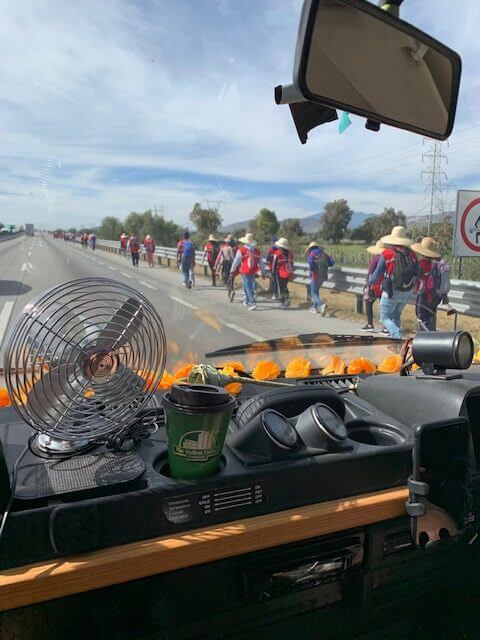
Pilgrims, pilgrims and still more pilgrims….we passed hundreds of them walking along the highway as we drove north from Oaxaca.

Maybe they were walking all the way to worship at the Shrine of Our Lady of Guadalupe in Mexico City. We weren’t sure where their spiritual journey was taking them.
Our destination was to see a miracle of the natural world – to see firsthand millions of Monarch butterflies resting, and hopefully at play, in their overwintering ground in the Sierra Madre mountains, west of Mexico City.

Every Autumn, these butterflies fly up to 3,000 miles from their breeding and feeding territories in Canada and northeastern U.S to the forests in the mountains which straddle the states of Mexico and Michoacán. By late March, they have all returned north. If it’s overcast or raining, the butterflies huddle together for warmth around the oyamel fir trees. We hoped we’d be there for a ‘good’ day when the warmth of the sun encouraged them to take flight.
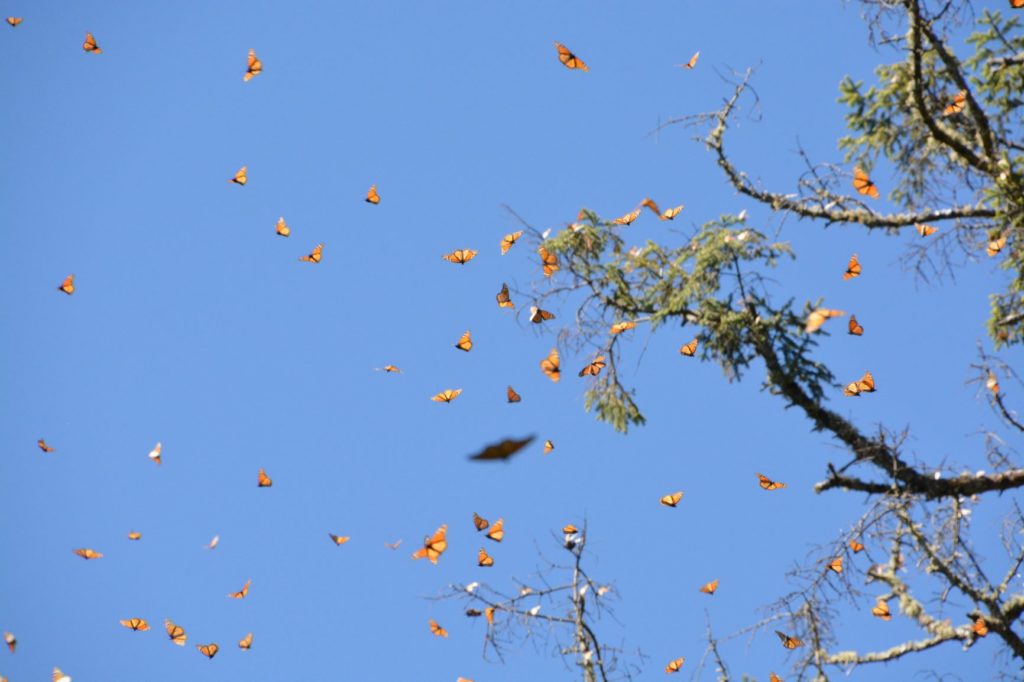
We were headed for the Monarch sanctuary at Sierra Chincua and planned on getting there with three overnight stops along the way. Our first was at Cholula, not far from the city of Puebla. On the iOverlander app, we found what looked like a good spot – a car park within walking distance of the town’s famous landmark, the Great Pyramid.

It was built in prehispanic times, bit by bit, over a thousand years to become the largest pyramid complex in the world. There is little to see of the ancient pyramid now. Covered in grass, it looks like a hill. And that is apparently also what the Spanish thought when they arrived in the 1500s and constructed a church on top of what was once a temple for the indigenous people.

We parked up, set out our chairs for a sunset beer and – with perfect timing – along came the snacks and nuts guy.


The church is up a steep climb…

…with a good view across to the Popocatepetl volcano.

Next morning we prepared to set off for nearby Puebla and hit the first of what turned out to a series of van troubles on our trip. The engine would not start. Dead as a dodo.

After some tinkering around – and a phone consultation with Karl our ever helpful mechanic back in London – Stuart got Molly going again after loosening the fuel supply to one of the injectors to bleed the air out and giving the engine a squirt of Damp Start.

That took him back to the days as a Hillman Imp owner.


We got to Puebla, the biggest city we had driven in so far but the traffic was manageable and we found our way to the police station where we planned to stay the night.

Yep, that’s right. Our hosts for the night were the tourist police of Puebla who very kindly allow passing campervanners park outside their station overnight and offer the use of the officers’ shower and toilet facilities.

All we had to do was give the front desk copies of our passports and we were free to use the facilities as and when we needed. And we were also given tips on which restaurants to try in Puebla though it was hard to focus on what the young police officer was saying. Chatting easily about the best place for tacos isn’t easy when your guide has a huge gun strapped to her front, pointing directly at your big toe.
We visited the elaborately ornate Biblioteca Palafoxiana…


…and had dinner in a small restaurant which specialized only in pozole. They are big steaming bowls of either red or green broth which come with side garnishes of fresh coriander, radishes, lime and chilli peppers. Stuart watched a local and did as he did, piling it all in to his bowl in one go. Not a good move for someone whose tolerance of fiery food is low. It blew his head off.
In return for their hospitality, the police officers asked if they could do a video interview with us about our thoughts on their city. We were delighted to oblige.


So somewhere on a tourist marketing site, there’s footage of the two of us gabbling enthusiastically about the delights of Puebla and pozole.

Next day we set off for Tula de Allende and for another night of wild camping. This time it was in a car park beside the town market but at least we had a hot shower the previous night so we weren’t feeling too grimy.
Once parked up, Stuart decided to stay in the car park and do manly things…like tinker with the van engine…

…and smoke one of the special cigars he got for Christmas.

I left him to it and headed up to the archaeological site, famous for its giant statues of Toltec warriors.

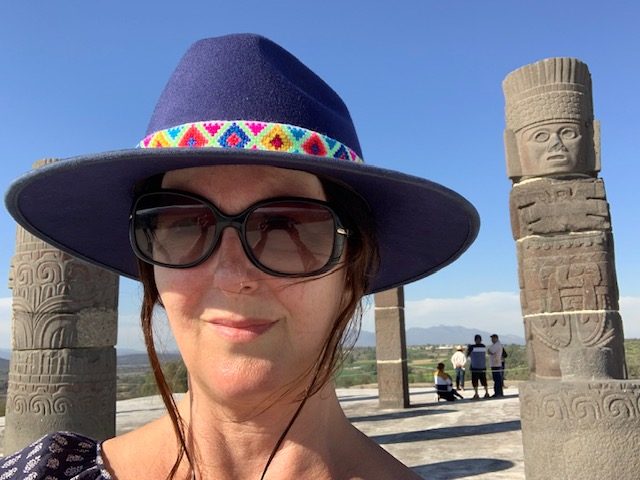

Local artist Antonio Fuentes showed me around his exhibition of paintings influenced by the flora in the park.

By day, Antonio works for the state-owned petroleum company Pemex – we know it well for diesel and loo stops and by night, he paints.

The next day when leaving to get to Sierra Chincua, we had the same problem starting the van and crossed our fingers that the spray of Damp Start would get us going and keep us going so we made it to the butterflies.

We made it.

It’s a long walk through the woods to get to the place to see them.

We turned down the many offers of a horse ride to get there.


When it seemed like most other visitors had small babies strapped to their front for the trek, it would have been very feeble of us to hitch a ride.

The butterflies were dazzling and we spent the rest of the afternoon there watching them flutter in mesmerized silence at them.

It took a while to realise that the orange and brown specks on the trees opposite were not leaves – they are all butterflies.

When we planned our travels to Mexico, there were three sights we definitely wanted to see – the Monarch butterflies, the gray whales at San Ignacio in Baja and the surrealist sculpture park of Edward James at Xilitla. We had now seen the first of the three ‘must sees’. We headed back to the van excited and elated by the experience of seeing them.


But as any VW owner will testify, our 30 year old van has a way of bringing you back down to earth. Molly refused to start once again.

What was causing it? Dirty diesel? The high altitude? We didn’t know and were very, very grateful that the spray of Damp Start got us going once again.

We left Sierra Chincua and headed down into the valley to the former mining town Mineral de Angangueo.


We had seen on iOverlander there was a car park on the edge of town that campervans could stay in overnight but when we got to what we thought was the right spot (going by the GPS coordinates given), the three local men parked up there having a chat and smoke shrugged at us and shook their heads. Clearly they weren’t keen on us parking up for the night. It was getting dark and we were getting worried about where we could stay but decided we would probably be safer if we were right in the centre of the town.

A cheery local was chuffed to bits at the sight of our old van pulling into the main square. He grinned and waved at us as we pulled by him into a side street. Could we ‘duerme’ there that ‘noche’? we asked in our atrocious Spanish. ‘Si, si’, he assured us. That was good enough for us. We parked up, conveniently close to an excellent taco stand where …

…we had one of the best meals of our travels in Mexico so far.
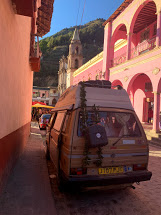
.Watched over by the street dogs, we had a good night’s sleep right beside the main square.

Next morning we had a wander around the town. It was a Monday and so unfortunately the Casa Parker museum was closed (it was the former home of expat mining engineer Bill Parker and his photographer wife Joyce). But we picked up much of the story of Angangueo from this mural..

…which covers the alleyway on both sides and graphically depicts the mining history of the town…

…including the tragic accident in 1953 which claimed the lives of 25 miners. That was the end of the American Smelting and Mining Company in Angangueo as the accident led to the nationalization of the mines.


Meeting Tigger’s Travels

Our next destination was Morelia which took us along a scenic mountain route.

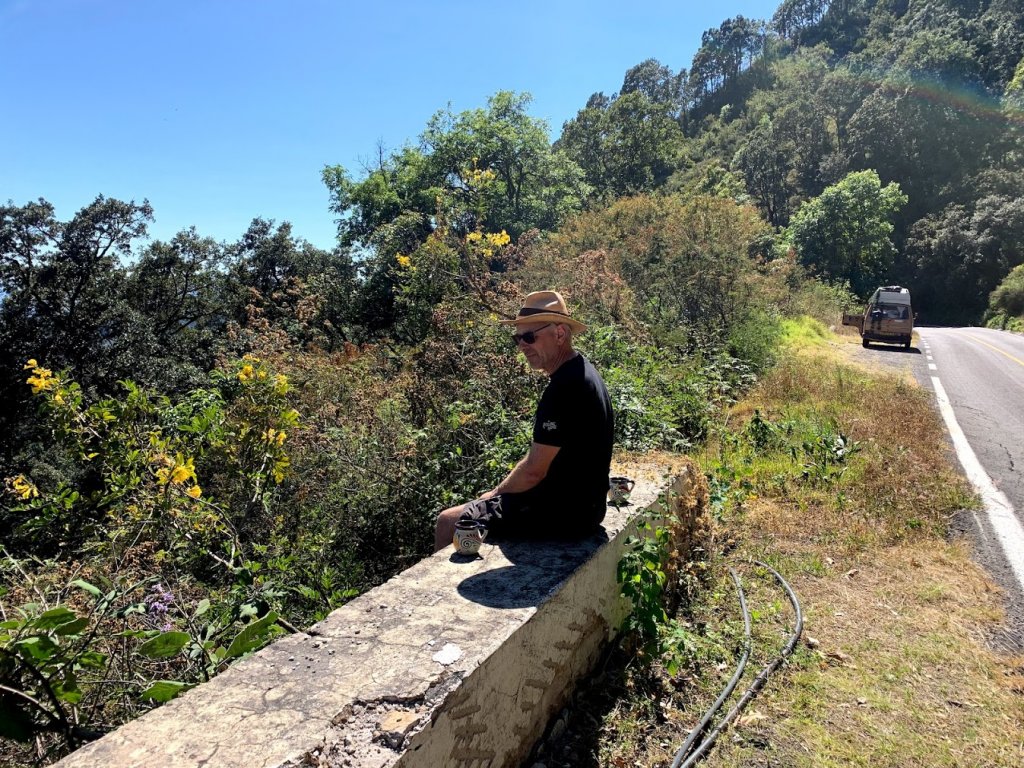
Going to Morelia was a last minute detour for us so we could meet with Suzanne and John Curran aka Tigger’s Travels. When we were first planning this trip to Mexico and the USA, we had been following them on Instagram. They have a T25 like ours though their van Tigger is, as the name suggests, a lot more eye-catching than Molly (bless her Timor Beige good looks).
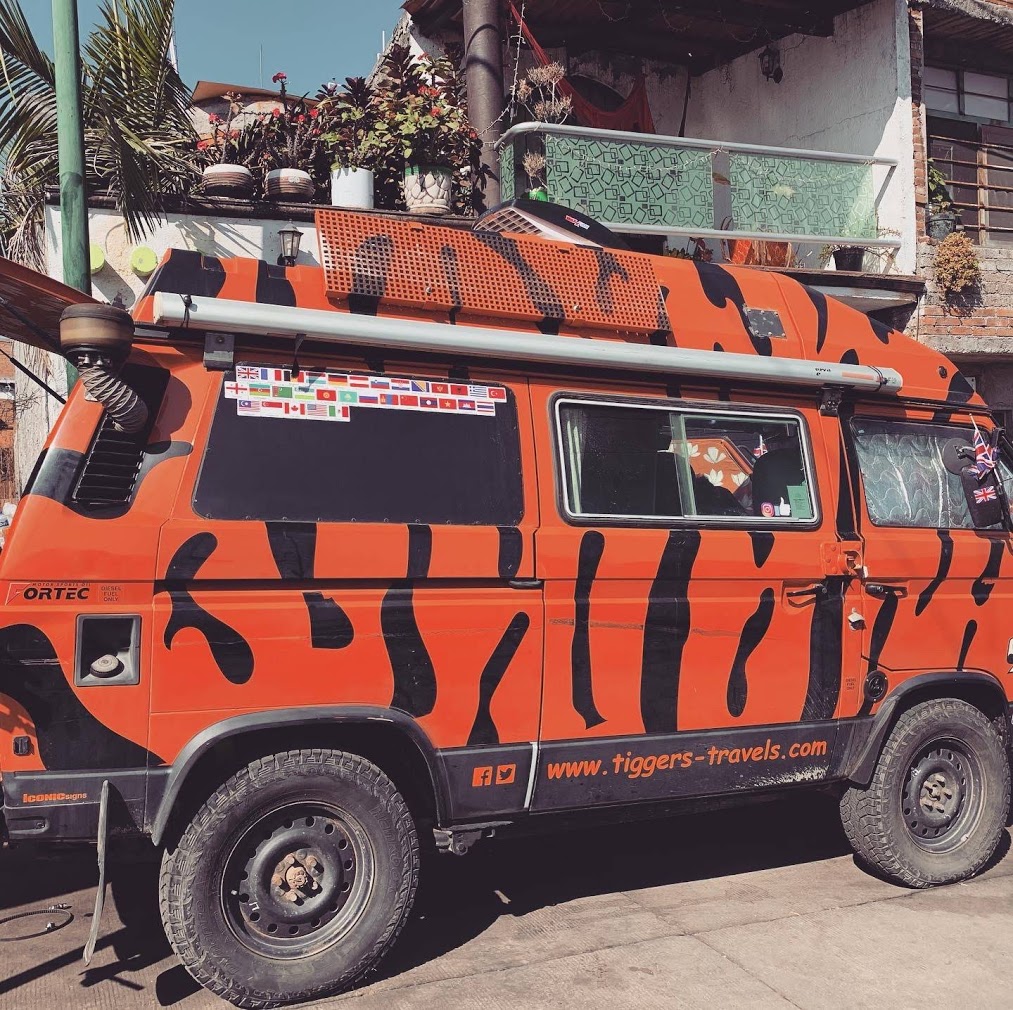
As well as following their posts, we had direct messaged them for advice and had a call with them to get information on travelling in Mexico. At that stage, we were planning to start our journey in Baltimore and then go south the Mexico before doing a loop back to the USA. On our call, they asked why we were not shipping the van direct to Veracruz. We hadn’t even considered it but it was a ‘light bulb’ moment for us. Why not?
It certainly made far more sense as it meant that the clock would only start ticking on our 6 month American B1/B2 Tourist visa once we crossed the border after our Mexico travels rather than as soon as we arrived in Baltimore. By going direct to Veracruz, we could take our time and enjoy Mexico as long as we felt like it and still have the full 6 months in the USA.
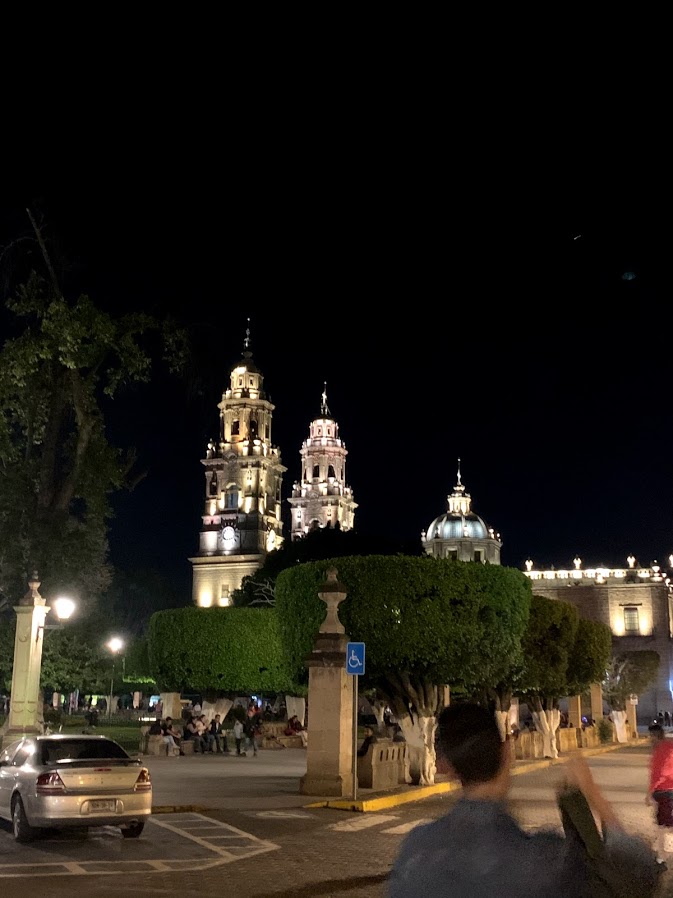
Suzanne and John were going to be travelling south through Mexico at the same time as us but for a while it seemed unlikely that our paths would cross. Unfortunately for them though, Tigger started giving them trouble, so much trouble that ultimately they were stuck in Morelia for weeks and faced having to replace the van’s engine. And Morelia was only a couple of hours drive from the butterflies. It was too good an opportunity to miss. We arranged to meet up with them…

…and had a great evening with them…

….which turned into nearly a week hanging around with them in Morelia once we decided to stay to see if the mechanic working on Tigger could also help sort Molly’s problems.
He did. Hugo the mechanic diagnosed problems with the injectors and glow plugs – which were knackered and burnt out – and put us in touch with Ivan the diesel specialist. He reconditioned the fuel injectors, provided new glow plug and praise be, that sorted the problem.

We said farewell to Tigger’s Travels and set off for the northernmost point in our travels around Mexico. Our destination – Xilitla and the surrealist Garden of Eden of Edward James.

